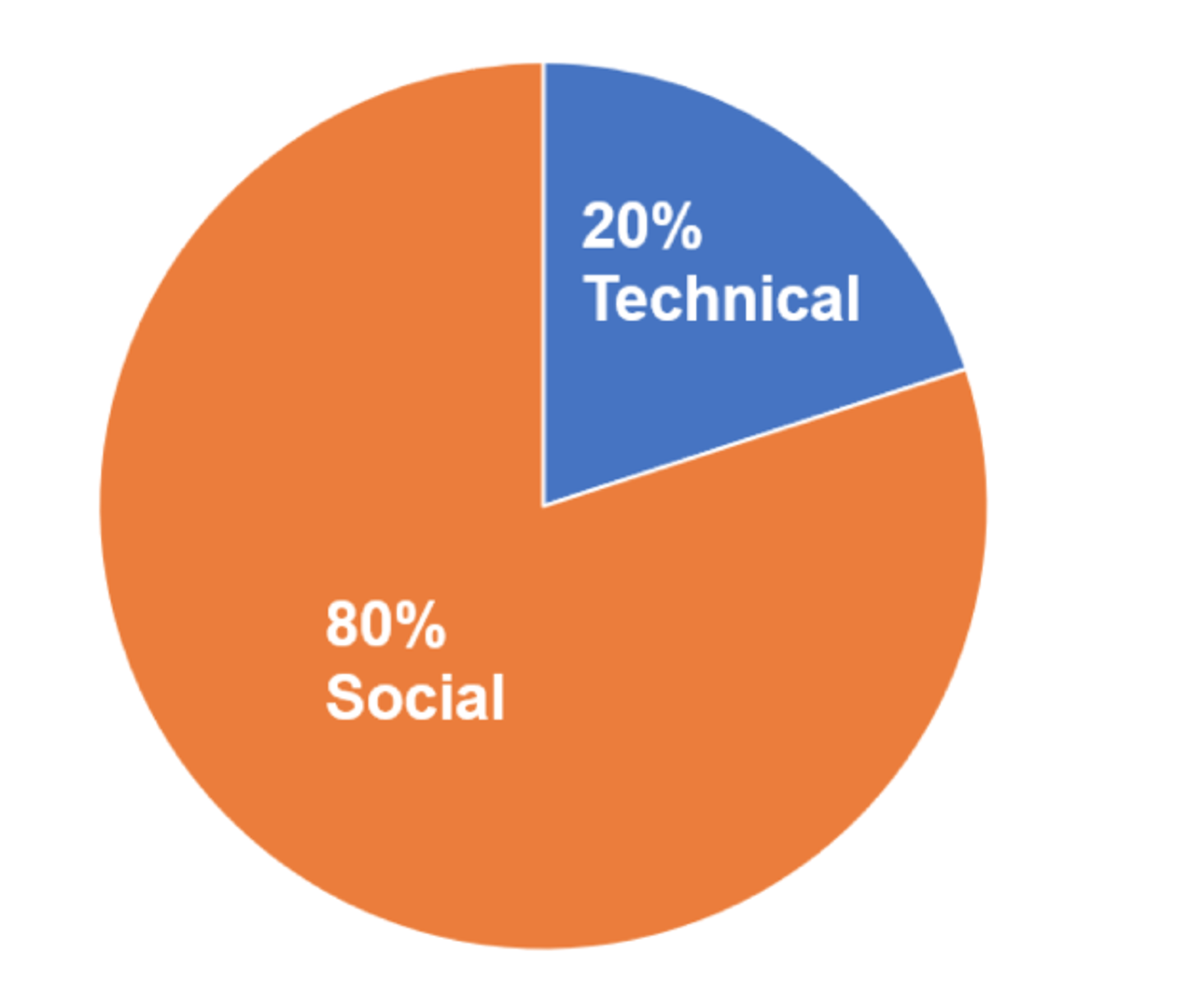Get the HR out of OKRs

Published 2023-06-15
Summary - There are two separate issues here: First, what are the organization’s OKRs? Second, how do we create an environment that ensures the successful implementation and execution of these OKRs?
Executive Summary
There are two separate issues here: First, what are the organization’s OKRs? Second, how do we create an environment that ensures the successful implementation and execution of these OKRs?
All leadership and OKRs practices are 20% technical and 80% social. So, the problem boils down to this – organizations often assign HR responsibility for building the OKR solution because they own 80% of the equation. However, most HR teams fail when setting the OKRs, leading to a failed OKR solution.
The lesson here is that we need to separate the setting of OKRs from how we manage with OKRs, and let process experts build the OKRs and OKR-dashboards for us (i.e. take the HR out of OKRs).
OKRs and their dashboards need to ensure that everyone is seeing and talking about the right things, which means we need to design the dashboards to trigger the right conversations.
How did HR sneak into OKRs?
In recent articles and books, we have seen ‘thought leaders’ making it seem like all Objective & Key Result (OKR) implementations require a significant overhaul of Human Resources (HR) practices. The requirement for an HR overhaul is not a fact and is not a good thing - in fact, I would argue that overhauling HR is probably a bad thing.
Now, don't get me wrong, I think those HR practices are a critical component of a successful strategy and OKR implementation, but they are a separate issue for the OKRs themselves.
I'm going to use the metaphor of driving a car for the rest of this post… think of when you learned how to drive. You probably spent one or two days in a classroom learning the rules and laws of the road. Think of those as your Objectives and Key Results.
Then came the tough part of learning to drive – the behaviours that enable a safe drive. That training was more like an apprenticeship as you worked one-on-one with a driving instructor, on the road, to learn what to do in various situations. That training most likely took about four times as long as the classroom. It has been said that driving is 20% technical, 80% social. After all, we all have the same dashboards (the technical part), but we certainly do not all drive the same!

All leadership – and definitely OKR practices, are also 20% technical and 80% social.
My recent Klipfolio article, Get the HR into OKRs, deals with the 80% social. This article deals with the 20% technical.
It's clear that drivers drive cars, not dashboards (well at least for now). But the dashboard does play a critical role in ensuring driver success. The dashboard makes sure that you as a driver has the data you need for a successful journey.
Vehicle dashboards differ depending on the driver’s strategy – race cars and tractors both have different dashboards than your car.

The dashboards that you build for your organization need to ensure that everyone has the proper data they need to ensure the organization’s success. OKRs are that right data that is carefully selected to ensure that they drive the organization’s success.
My suggestion - OKRs need to be separated from HR.
OKRs need to provide you with the right information, at the right time, in the right place. And then comes the tough part - creating the culture, environment and structures to ensure successful OKR execution, when overlaid on the existing powerful HR processes.
The pressure on the HR processes for successful OKR implementations is largely caused by the increased speed, increased users, and new and timely performance data – not because there are HR practices that you are not following.
Diving Deeper
It boils down to organizations often assigning HR the responsibility for building the OKR solution because they own 80% of the equation, but most HR teams have difficulty in setting up those OKRs, because they are the in-car driving instructors, not the engineers that design and build dashboards.
The problems we typically see within HR teams as they try to set OKRs include:
- The organization is unclear on their strategic objectives and strategic priorities, so HR has nothing to build on
- The organization has not effectively cascaded the strategy down to department, teams and individuals, so the departments, teams and individuals cannot figure out their purpose - what the organization needs from them
- The organization has not been clear on the specific performance results and timing, so people cannot track their progress towards the goal(s)
- The organization may need new data sources or analytics, and the skills, authority resources to build those new sources are outside the scope of HR
- HR competency is not often related to performance metrics and numeracy
The lesson here again, is that we need to separate the setting of OKRs from how we manage with OKRs (i.e. take the HR out of OKRs).
Since the OKRs, and their dashboards need to ensure the everyone is seeing and talking about the right things, we need to structure the dashboards to trigger the right conversations.
Experience indicates that there are 6 types of conversations related to performance that go on in organizations (in no particular order):
- Valuation – Conversations around how to increase the valuation of the business. Dashboards here need to help stakeholders understand how value has been created and/or the future value likely from current and future activities. Valuation scorecards using metrics that can be “dollarized,” typically need to mirror generally accepted accounting principles (GAPP). 90% of OKRs are not useful in a valuation view.
- Navigation – Conversations that use near real-time information to help executives and others make decisions on which direction to take the organization. Navigation scorecards tend to use leading, process-based indicators and frequently need multiple comparatives to guide the reader. The majority of OKRs appear in Navigation dashboards.
- Compensation – Conversations around how to reward people. Typical metrics are lagging, outcome related, and auditable. Compensation scorecards/dashboards use SMART indicators. Do not use OKRs in any compensation dashboards – it will lead to dirty data and incorrect decision-making.
- Calibration - Calibration, or benchmarking, conversations are centered around how your organization is performing against other organizations with a similar strategy. Calibration dashboards typically lack the depth and breadth to support OKRs.
- Communication – Conversations by stakeholders, such as board members, investors, and the broader community. They need simple, aggregate data, to understand the strategy and how the organization is performing. OKRs will never appear in a communication conversation.
- Regulation - Regulatory conversations conform to one or more externally-set frameworks…health & safety, food, financial, etc. Regulatory frameworks are unique from any of the above and are intended for a specific audience around a specific issue. In some cases, regulatory objectives and key results do end up in your organization’s OKRs.
OKR solutions are typically of a navigational nature - they're trying to help teams and employees navigate themselves correctly towards strategic success. Our experience indicates that if OKRs are used for compensation, it skews the data because, as Maslow has taught us, people need to ensure food and shelter for ourselves and our families. You may find that reported OKR performance is not the same as the actual performance!
The good news is that navigational data usually comes from the transaction world – data captured about what customers and employees do day-to-day. Great examples of sources of navigational data include Google Analytics from your website, LinkedIn, Glass Door, etc. Most organizations already have this data!
Read Get the HR into OKRs next.
About Pm2
Brett is an Executive Partner at Pm2 (Performance Measurement & Management) an international consulting firm specializing in the development and implementation of strategic dashboards and scorecards. The frameworks they use includes OKRs (Objective and Key Results), Balanced Scorecard, 4DX (Four Disciplines of Execution) Lean, Six-Sigma, etc. Their work has been profiled in Harvard Business Review, Fortune and Forbes magazines as well as countless business books and periodicals. We are pleased to have this thought leader as an active contributor to our blog posts.
Related Articles

What you should measure in employee performance reviews
By Matt Shealy — February 3rd, 2020
Implementing OKRs, faster, cheaper, better – and easier
By Brett Knowles — December 9th, 2019
Are your 'Key Results' undermining your 'Objectives'?
By Brett Knowles — October 18th, 2019

